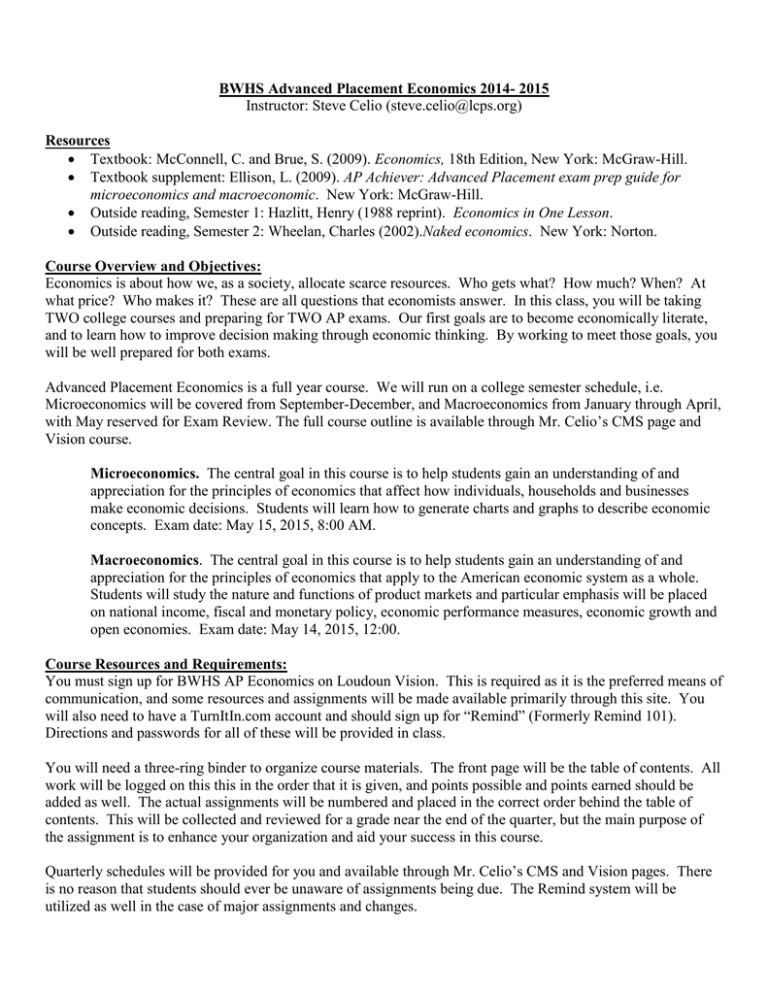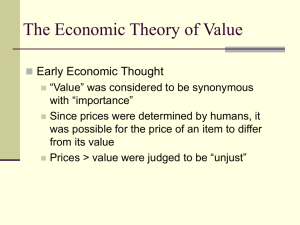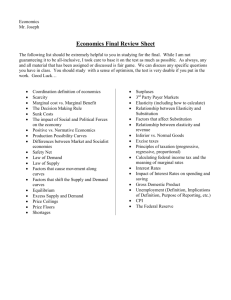AP Econ Syllabus 14-15 - Loudoun County Public Schools
advertisement

BWHS Advanced Placement Economics 2014- 2015 Instructor: Steve Celio (steve.celio@lcps.org) Resources Textbook: McConnell, C. and Brue, S. (2009). Economics, 18th Edition, New York: McGraw-Hill. Textbook supplement: Ellison, L. (2009). AP Achiever: Advanced Placement exam prep guide for microeconomics and macroeconomic. New York: McGraw-Hill. Outside reading, Semester 1: Hazlitt, Henry (1988 reprint). Economics in One Lesson. Outside reading, Semester 2: Wheelan, Charles (2002).Naked economics. New York: Norton. Course Overview and Objectives: Economics is about how we, as a society, allocate scarce resources. Who gets what? How much? When? At what price? Who makes it? These are all questions that economists answer. In this class, you will be taking TWO college courses and preparing for TWO AP exams. Our first goals are to become economically literate, and to learn how to improve decision making through economic thinking. By working to meet those goals, you will be well prepared for both exams. Advanced Placement Economics is a full year course. We will run on a college semester schedule, i.e. Microeconomics will be covered from September-December, and Macroeconomics from January through April, with May reserved for Exam Review. The full course outline is available through Mr. Celio’s CMS page and Vision course. Microeconomics. The central goal in this course is to help students gain an understanding of and appreciation for the principles of economics that affect how individuals, households and businesses make economic decisions. Students will learn how to generate charts and graphs to describe economic concepts. Exam date: May 15, 2015, 8:00 AM. Macroeconomics. The central goal in this course is to help students gain an understanding of and appreciation for the principles of economics that apply to the American economic system as a whole. Students will study the nature and functions of product markets and particular emphasis will be placed on national income, fiscal and monetary policy, economic performance measures, economic growth and open economies. Exam date: May 14, 2015, 12:00. Course Resources and Requirements: You must sign up for BWHS AP Economics on Loudoun Vision. This is required as it is the preferred means of communication, and some resources and assignments will be made available primarily through this site. You will also need to have a TurnItIn.com account and should sign up for “Remind” (Formerly Remind 101). Directions and passwords for all of these will be provided in class. You will need a three-ring binder to organize course materials. The front page will be the table of contents. All work will be logged on this this in the order that it is given, and points possible and points earned should be added as well. The actual assignments will be numbered and placed in the correct order behind the table of contents. This will be collected and reviewed for a grade near the end of the quarter, but the main purpose of the assignment is to enhance your organization and aid your success in this course. Quarterly schedules will be provided for you and available through Mr. Celio’s CMS and Vision pages. There is no reason that students should ever be unaware of assignments being due. The Remind system will be utilized as well in the case of major assignments and changes. Grading: Category % of Brief description grade Daily “frames” 0 Writing/graphing exercises to reinforce key concepts and identify areas where clarification or re-teaching may be necessary Classroom activities 10 Worksheets, free responses, etc., done individually or in pairs. Sometimes graded on performance, sometimes on completion. Students may be assigned to complete these as homework. Chapter quizzes 20 Generally 10 questions on each chapter, includes reading and vocab questions Problem sets 15 One per unit, serves as concept reinforcement and test review Unit Tests 35 Cover between 3-5 chapters 60 MC questions, 1-2 FRQs Projects 15 One per quarter, based on books or articles Notebook 5 Graded on completion, for organizational purposes Classroom Expectations and Policies: 1. Be on time, be prepared, and be polite. 2. All school rules (e.g. Honor Code, tardy policy, phone/iPod rules, etc.) will be enforced in class. 3. Economics class is the time for economics work, students should remain focused and on-task. 4. Keep up with your reading and outline your chapters. There are also many practice options on-line and in the review book to reinforce your learning. 5. Do your homework! You are also expected to complete any work that we do not finish during class. 6. If you do not understand something ASK QUESTIONS. We need to correct misunderstandings as they arise. Correct mistakes in your assignments. 7. All work is due at the beginning of class on the day identified on the quarterly schedules. These dates will only change in the case of extenuating circumstances such as snow days. 8. Students who miss class are expected to turn in any assignments that were due as soon as they return to class. Turning it in at this time is the student’s responsibility, if they fail to do so it will be treated as late work. 9. Late work policy: For tests/quizzes missed for excused absences/tardiness, the student is responsible for scheduling a make-up time to be completed within one week of their return to class. Failure to do so will result in a grade of 50% being assigned. Missed test or quizzes for unexcused absences or tardiness will result in a grade of 50% being assigned. The notebooks and projects will be due on the dates identified on the calendar, and will be assessed a 25-point penalty for each day they are late. In-class activities and homework assignments, including problem sets, will not be accepted late except in the cases of excused absences. A grade of 20% will be given for missed homework assignments. 10. Students should monitor their grades via Clarity, and notify Mr. Celio of any discrepancies via email (to allow him to have a record of the issue) as soon as they become aware of it. 11. Due to the timing and structure of the course, all students, including seniors, will take the mid-term and final exam. Seniors who meet the LCPS Exam Exemption criteria will have the option of not counting their exam, or counting it if it improves their final grade. Acknowledgement of Class Policies for AP Economics Classroom Expectations and Policies: 1. Be on time, be prepared, and be polite. 2. All school rules (e.g. Honor Code, tardy policy, phone/iPod rules, etc.) will be enforced in class. 3. Economics class is the time for economics work, students should remain focused and on-task 4. Keep up with the reading and outline your chapters. There are also many practice options on-line and in the review book to reinforce your learning. 5. Do your homework! You are also expected to complete any work that we do not finish during class. 6. If you do not understand something ASK QUESTIONS. We need to correct misunderstanings as they arise. Correct mistakes in your assignments. 7. All work is due at the beginning of class on the day identified on the quarterly schedules. These dates will only change in the case of extenuating circumstances such as snow days. 8. Students who miss class are expected to turn in any assignments that were due as soon as they return to class. Turning it in at this time is the student’s responsibility, if they fail to do so it will be treated as late work. 9. Late work policy: For tests/quizzes missed for excused absences/tardiness, the student is responsible for scheduling a make-up time to be completed within one week of their return to class. Failure to do so will result in a grade of 50% being assigned. Missed test or quizzes for unexcused absences or tardiness will result in a grade of 50% being assigned. The notebooks and projects will be due on the dates identified on the calendar, and will be assessed a 25-point penalty for each day they are late. In-class activities and homework assignments, incuding problem sets, will not be accepted late except in the cases of excused absences. A grade of 20% will be given for missed homework assignments. 10. Students should monitor their grades via Clarity, and notify Mr. Celio of any discrepancies via email (to allow him to have a record of the issue) as soon as they become aware of it. 11. Due to the timing and structure of the course, all students, including seniors, will take the mid-term and final exam. Seniors who meet the LCPS Exam Exemption criteria will have the option of not counting their exam, or counting it if it improves their final grade. I understand the aforementioned expectations and policies for AP Economics, and will abide by them. ______________________________________________ Name __________________ Date ______________________________________________ Signature ___________________ Phone # (optional) Key vocab terms: (these are the most significant terms in each chapter, but this is not a comprehensive list of what you need to know) Chapter 1: Economics, utility, marginal utility, scarcity, opportunity cost, production possibilities curve, capital goods, consumer goods, economic growth, factors of production (identify), comparative advantage Chapter 2: Money, barter, command economy, market economy, competition, invisible hand, dollar votes Chapter 4: Durable v. non-durable goods, monopoly, externality, public good, free-rider problem, transfer payment, externality, marginal tax rates, excise tax Chapter 3: Demand, law of demand, diminishing marginal utility, income effect, substitution effect, inferior goods, normal goods, substitute good, complementary goods, supply, determinants of supply, equilibrium price/quantity, surplus, shortage, productive efficiency, allocative efficiency Chapter 6: Price elasticity of demand, unit elasticity, elastic demand, inelastic demand, perfectly elastic demand, perfectly inelastic demand, total revenue test, price elasticity of supply, market period, short run, long run, cross-elasticity of demand, income elasticity of demand, consumer surplus, producer surplus, efficiency loss Chapter 7: Utility, law of diminishing marginal utility, total utility, marginal utility, rational behavior, budget constraints, consumer equilibrium, income effect, substitution effect Chapter 8: Opportunity cost, explicit costs, implicit costs, normal profit, economic profit, total product, marginal product, average product, law of diminishing returns, fixed costs, variable cost, total cost, marginal costs, economies of scale, returns to scale, minimum efficient scale, natural monopoly Chapter 9: Pure competition, imperfect competition, price taker, average revenue, total revenue, marginal revenue, break- even point, MR=MC rule, short-run supply curve, constant-cost industry, increasing cost industry, [productive efficiency, allocative efficiency, consumer surplus, producer surplus in context] Chapter 10: Pure monopoly, barriers to entry, simultaneous consumption, network effects, X-inefficiency, price discrimination, socially optimal price, fair-return price Chapter 11: Monopolistic competition, product differentiation, non-price competition, Four-firm concentration ratio, Excess capacity, oligopoly, Mutual interdependence, game theory, collusion, price war, cartel Chapter 12: Derived demand, marginal product, marginal revenue product, marginal resource cost, MRP=MRC rule, elasticity of resource demand, least-cost combination of resources, profit-maximizing combination of resources Chapter 13: Wage rate, nominal wage, real wage, purely competitive labor market, monopsony, minimum wage, wage differentials, human capital Chapter 14: Economic rent, incentive function, time-value of money, nominal interest rate, real interest rate, Explicit costs, implicit costs, economic profit, normal profit Chapter 16: Private goods, public goods, free-rider program, cost-benefit analysis, externalities, Coase Theorem, asymmetric information, moral hazard problem, adverse selection problem Chapter 17: Public Choice Theory, logrolling, special-interest effect, benefits received principle, ability to pay principle, progressive tax, regressive tax, proportional tax, efficiency loss of a tax Chapter 20: Lorenzo Curve, Gini ratio, equality efficiency trade off Chapter 23: The business cycle; recession; real gross domestic product (GDP); nominal GDP; unemployment, financial investment, economic investment, demand shocks, supply shocks, sticky prices, inflation. Chapter 24: National income accounting; value added; expenditures approach (know parts- C, I, G & X); income approach (know parts), national income; personal income; disposable income; price index Chapter 25: Economic growth; real GDP per capita; labor productivity; infrastructure; human capital Chapter 26: Peak; trough; expansion, labor force; unemployment rate; three types (frictional, structural and cyclical) of unemployment, full rate of unemployment, natural rate of unemployment, Okun’s law; Consumer Price Index (CPI); Demand-pull v. cost-push inflation; deflation; nominal income, real income, cost-of-living adjustments, hyperinflation Chapter 27: Consumption schedule, saving schedule, break even income, Average propensity to consume (save), Marginal propensity to consume (save), Wealth effect, Expected rate of return, Multiplier Chapter 28: Planned investment, Investment schedule, Aggregate expenditures schedule, Equilibrium GDP, leakage, injection, net exports, recessionary expenditure gap, inflationary expenditure gap Chapter 29: Aggregate demand-aggregate supply (AD-AS) model, Aggregate demand, Interest rate effect, Determinants of aggregate demand, Aggregate supply, Short-run aggregate supply curve, Determinants of aggregate supply, Productivity, Equilibrium price level, Equilibrium real output Chapter 30: Fiscal policy, Budget deficit/surplus, built-in (automatic) stabilizers, progressive tax system, crowding out effect, public debt, US securities Chapter 31: Liquidity, M1, M2, commercial banks, Federal Reserve System, Federal Open Market Commission Chapter 32: Fractional reserves banking system, balance sheet, required reserves, reserve ratios, Federal funds rate, monetary multiplier Chapter 33: Monetary policy, interest, transactions demand, asset demand, open market, discount rate, Federal Funds Rate, prime interest rate, Taylor Rule Chapter 35: Phillips Curve; Stagflation; Aggregate supply shocks; Long-run vertical Phillips Curve, Supplyside economics; LafferCurve Chapter 37: Comparative advantage (again), Terms of trade; Trading possibilities line,, gains from trade,world price, domestic price, export supply curve, tariffs (types), nontariff barrier, Dumping, World Trade Organization (WTO) Chapter 38: Balance of payments; Current account; Trade deficit; Trade surplus; Official reserves, Floating exchange rate system; Fixed-exchange-rate system; Purchasing power parity theory; Currency intervention; Exchange controls Microeconomic Outline (1stSemester) Unit 1: Basic Economic Concepts (Chapters 1, 2, 4&5, McConnell & Brue) A. Founding Principles Scarcity, the economizing problem Tradeoffs and Opportunity Cost Free-market system (Adam Smith’s invisible hand) B. Types of Economics Microeconomics vs. macroeconomics Positive economics vs. normative economics C. Production Possibilities Graph Straight vs. bowed PPF Underutilization, full employment, and unattainable Law of increasing opportunity cost 3 shifters of the PPF Consumer goods vs. capital goods D. Circular Flow Model Product market, Factor market, and Public/Private sector E. Specialization and Trade Absolute advantage Comparative advantage Unit 2: Supply, Demand, And Consumer Choice (Chapters 3, 6, & 7. McConnell & Brue) A. Demand (graph) Law of demand Market demand curve Determinants of demand Normal vs. inferior goods Substitutes and complements B. Supply (graph) Law of supply Market supply curve Determinants of supply C. Equilibrium and Efficiency (graph) Equilibrium price and quantity Disequilibrium: surplus and shortages (graphing) D. Government Policies (graphs) Price floors and Price ceilings Excise taxes, Subsidies, Tariffs, Quotas E. Elasticity Price, Income, and Cross Price elasticity of demand The total revenue test (graph) F. Consumer Choice Law of diminishing marginal utility, Substitution effect, Income effect Marginal benefit/cost Utility maximizing rule Unit 3 Costs of Production and Perfect Competition (Chapters 8&9.McConnell & Brue.) A. Economists vs. Accountants Total revenue Explicit and Implicit costs Economic costs and profits B. Costs of Production (graph) Fixed Costs, Variable costs, and Total costs Per-unit costs (AVC, AFC, ATC) Shifts in MC, ATC. AVC, and AFC Marginal costs and Marginal revenue Sunk costs C. Law of Diminishing Marginal Returns (graph) Stage I: increasing returns Stage II: decreasing returns Stage III: negative returns D. Long-run Production Costs (graph) Economies of scale, Constant Returns to scale, Diseconomies of scale E. Characteristics of Perfect Competition Price takers Demand = MR= Price Graph: Firm vs. industry (market) Short-run (profit or loss) Long-run equilibrium (New firm enter and exit) Normal profit Shutdown decision (P< AVC) Productive efficiency (P = Min ATC) Allocative efficiency (P = MC) 2nd Quarter Unit 4 Imperfect Competition (Chapters 10&11. McConnell & Brue) A. Characteristics of Monopolies Barriers to entry MR below demand (graphs) Profit-maximizing price and quantity Natural monopoly B. Effects on overall economy Compared to competitive industry Dead-weight loss X-efficiency C. Price discrimination (graph) Purpose and results Graph (MR=D) D. Regulation Unregulated price, Fair return price, and Socially optimal price Taxes and subsidies E. Characteristics of Monopolistic Competition Long-run equilibrium (graph) Excess capacity Non-price competition Product differentiation F. Characteristics of Oligopolies Kinked demand curve-competitive pricing Game theory (chart) price leadership Collusion and cartels Unit 5 Resource Market (Chapters 12, 13& 14. McConnell & Brue) A. Demand for labor Derived demand Marginal revenue product Marginal resource cost B. Perfectly competitive labor market (graph) Wage makers Perfectly elastic supply of labor C. Monopsony (graph) Wages and quantity compared to perfectly competitive labor market D. Labor Unions Goals and methods E. Effects of Minimum Wage F. Wage differentials Investment in human capital vs. physical capital G Rent, Interest and Profit Distribution of Income Capital and Interest Loanable Funds market Unit 6 Market Failures and Government Involvement (Chapters 16, 17& 20. McConnell & Brue) A. Public goods Demand for public goods Supply of public goods Free-rider problem Non-excludability and Non-rivalry B. Positive externalities/spillover benefits (graph) Marginal social benefits vs. private benefits Underallocation Government remedy C. Negative externalities/spillover costs (graph) Marginal social cost vs. private cost Overallocation Government remedy D. Economics of Taxation (Tax Burden) Progressive tax systems Regressive tax systems Proportional tax systems E. Income distribution Lorenz curve (graph) Tax incidences Macroeconomic Outline (2nd Semester) Third Quarter Unit 7: Macroeconomic Data and Measurement (Chapters 23 &24 McConnell& Brue) A. Introduction to Macro Basic Concepts Long Run vs. Short Run Demand Shock vs. Supply Shock (Sticky Prices) B. GDP (Nominal and Real values) Expenditure approach Income Approach Unit 8: Inflation and Unemployment (Chapters 25 &26 ) A. Economic Growth Rate of Economic Growth Real GDP Economic Growth and PPC Labor Productivity B. Business Cycle C. Inflation CPI Demand- Pull and Cost Push D. Unemployment Types of unemployment GDP Gap and Okun’s Law Unit 9: Consumptions vs. Savings (Chapters 27& 28) A. Average and marginal Propensities to Consume and Save MPC and MPS as Slopes B. Interest Rates Expected Rate of Return Real Interest Rates C. Multiplier Effect Changes in Spending and changes in Real GDP D. International Trade and the Public Sector Recessionary Gap vs. Inflationary Gap Fourth Quarter Unit 10: Aggregate Demand and Aggregate Supply (Chapters 29 & 35) A. Aggregate Demand Changes in Aggregate Demand Aggregate Demand Curve Determinants of AD B. Aggregate Supply Output in Immediate Short Run, Short Run and Long Run Aggregate Supply Curve Determinants of AS C. Fiscal Policy Expansionary vs. Contractionary Fiscal Policy Built in Stabilizers Crowding Out effect Unit 11: Money and Banking& Long Run AS (Chapter 30, 31, 32, 33& 35) A. Money M1 M2 B. Banking Federal Reserve System Globalization of Financial markets C. Money Creation and Monetary Policy Reserve Requirement and Discount Rate Reserve Ratio Monetary Multiplier Interest Rates Taylor Rule (Federal Funds Rate) D. Long Run Aggregate Supply Short Run AS vs. Long Run AS Long Run Equilibrium Demand –Pull Inflation Phillips Curve and Stagflation E. Supply Side Theory Laffer Curve Application of Supply Side Theory Unit 12: Exchange Rates/ Trade Deficit (Chapter 37 &38) A. International Trade Key facts and Basis for Trade PPC Comparative advantage Gains from Trade Free Trade vs. Protectionist Theory (WTO) B. Balance of Payments C. Flexible Exchange Rates D. Fixed Exchange Rates Macroeconomics Final Exam






